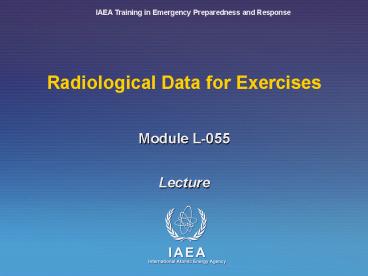Module L-055 - PowerPoint PPT Presentation
Title:
Module L-055
Description:
Title: Preparing, Conduct and Evaluation of Exercises to Test Preparedness for a Nuclear or Radiological Emergency Author: MELNICK, Stephen Last modified by – PowerPoint PPT presentation
Number of Views:34
Avg rating:3.0/5.0
Title: Module L-055
1
Radiological Data for Exercises
IAEA Training in Emergency Preparedness and
Response
- Module L-055
Lecture
2
Objectives
- Know what radiological data is needed
- Know how radiological data can be generated and
the tools that can be used - Know the limitation of those tools
- Understand the pros and cons of using real
weather during an exercise
3
Why is Radiological Data Important?
- Because radiological data drives the exercise
4
Type of Radiological Data
- In-facility
- Ambient radiation
- Contamination
- Air concentrations
- Environmental
- Ambient radiation
- Contamination
- Air concentrations
- Isotopic data
5
Type of Radiological Data (Contd)
- At the off-site traffic control points
- Ambient radiation
- Contamination (vehicles and people)
- At the reception centre or hospital
- Contamination (vehicles and people)
- Casualties
- Contamination
- Dosimeter readings
6
Producing Radiological Data (1)
- In-facility data
- Simulator
- Safety analysis
- Shielding models
7
Producing Radiological Data (2)
- Environmental data
- Source term from safety analysis
- Customize the release fractions, rate of release
and release profile in time to fit the emergency
scenario - Use dose projection software to generate doses
vs. distance and time - Some software has time-dependent source terms,
variable winds, and provides measurable
quantities such as dose rates and airborne
concentration at any given time - Most do not
8
Producing Radiological Data (3)
- Environmental data (contd)
- If the release profile is known, dose projections
can be converted to dose rates, instantaneous
airborne concentrations, ground shine and ground
contamination - Dose rates and airborne concentrations can be
converted to instrument readings - Using instrument specifications and sampling
procedures as guides - Random elements introduced in the software
9
Producing Radiological Data (4)
- People and vehicle contamination
- Use arbitrary values
- Requires some judgement
- Contamination level depends on location and
duration of stay or travel
10
Producing Radiological Data (5)
- Dosimetry
- Most difficult values to simulate
- Depends on type location profile of each
individual - Can be simulated to cause key events
- e.g. Report of a dose greater than 5 mSv to force
staff rotation - For free play, integrate based on dose rate data
- If dose control is a major objective, have an
individual or a team dedicated to the simulation
of dose readings
11
How to Present Radiological Data (1)
- In-station radiological data
- Colour-coded layout of the station
- Discrete time intervals
12
How to Present Radiological Data (2)
13
How to Present Radiological Data (3)
- Environmental data
- There are several ways. Two are presented as
examples - Method 1 one map of relevant data for each time
interval - Method 2 single map of integrated plume
trajectory coupled with time-dependent tables - Colour codes can be used but may be difficult to
reproduce
14
Map (1)
15
Table (2)
0.1
0.1
0.1
Pole 103
0.1
0.1
0.1
0.1
0.1
0.1
0.2
0.1
0.1
0.1
0.1
0.2
0.1
Pole 104
0.2
0.2
0.1
0.2
0.1
0.2
0.2
0.2
0.1
0.1
0.2
0.2
0.1
Pole 105
0.2
0.1
0.2
0.2
0.3
0.2
0.2
0.1
0.2
0.1
0.2
0.1
0.1
Pole 106
0.2
0.1
0.2
0.2
0.2
0.1
0.1
0.2
0.2
0.2
0.2
0.1
0.2
Pole 107
0.1
0.1
0.1
0.1
0.1
0.1
0.1
0.1
0.1
0.1
0.1
0.1
0.1
Pole 108
0.1
0.1
0.1
0.1
0.1
0.1
0.1
0.1
0.1
0.1
0.1
0.1
0.1
South Musquash
0.1
0.1
0.1
0.1
0.1
0.1
0.1
0.1
0.1
0.1
0.1
0.1
0.1
16
Real-time software
- Some programs allow real-time simulation of dose
rate and contamination data
17
How to Present Radiological Data (4)
- Contamination data
- At fixed points table of values vs. time
- Large areas maps or layouts for each major time
interval - Persons and vehicles pictures
18
Contamination Data
19
Contamination Data (Contd)
20 - 25 cps
15 - 20 cps
10 - 15 cps
5 - 10 cps
20
Contamination Data (Contd)
21
How to Present Radiological Data (5)
- Isotopic data
- Reverse-engineered to fit the dispersion and dose
projection results - Provide isotopic concentration tables or spectrum
22
How To Read The Data
- Provide the data when requested and when deserved
- Avoid showing time dependent graphs all at once
- If you make a mistake, admit it and provide the
right number - All field controllers who are responsible for
supplying radiological data must be well trained
on how to provide that data
23
Limitations of Tools
- Not always realistic
- Some judgment and interpretation by the
controllers necessary - Difficult to account for wind variability
- However, these limitations are not significant
given that the aim is to exercise the
relationship between surveys and decision-making
24
Real or Simulated Weather?
- Simulated weather
- Easier to produce the radiological data
- Easier to control the exercise
- Introduces artificiality
- Real weather
- Better test of the coordination between weather
and survey teams - More realistic
- Cannot pre-set the radiological survey injects
- Requires calculations on the fly
- Requires an extremely good coordination within
the control team
25
Summary
- Radiological data is the core of the exercise
data - Several parameters required, although not all of
them may be necessary for a single exercise - The development of radiological data requires
extensive analysis work - The provision of radiological data requires
experienced and trained controllers - Real weather is better than simulated, but much
more difficult to manage































